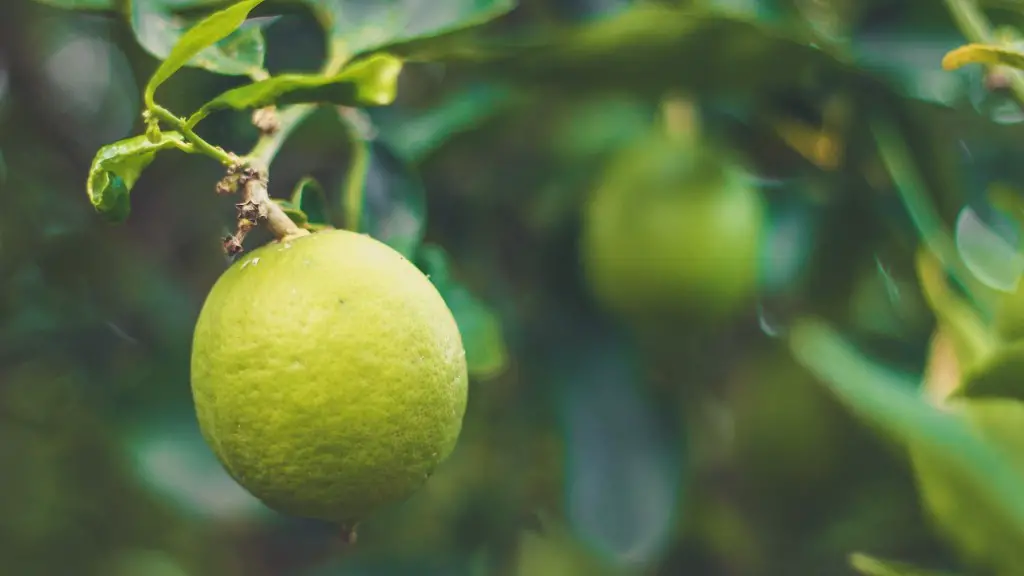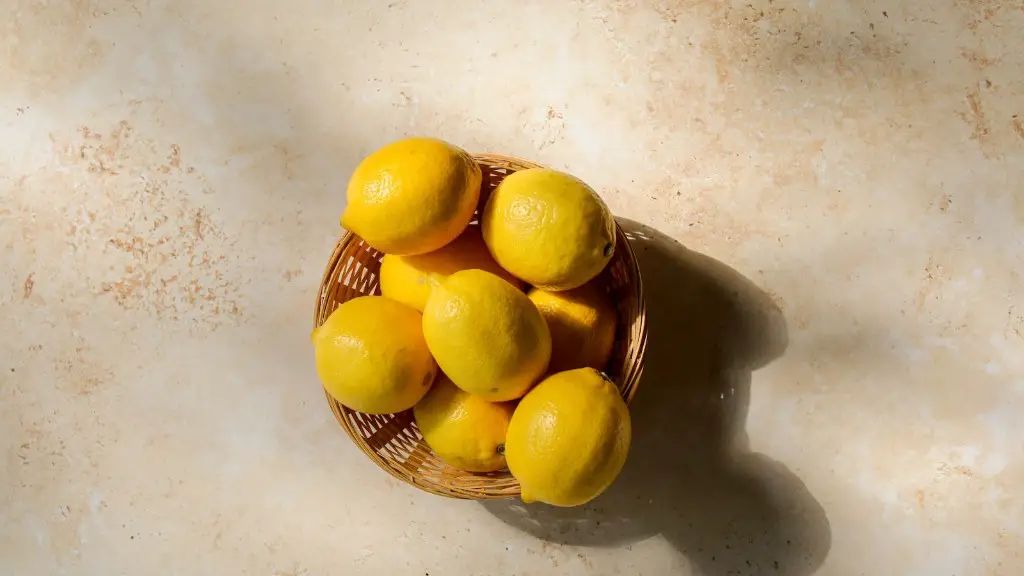When deciding what size pot to use for a dwarf lemon tree, it’s important to consider both your individual tree and its current age. At mature size, a dwarf lemon tree can reach 1.5–2 m in height and width, and require a large pot to accommodate its size, hence it’s vital to pick the right size from the start. Mature trees require a 50–75 cm pot and should be repotted every 2–3 years. Younger trees will require a smaller pot and should always be repotted as the tree grows.
To ensure the best growth of your dwarf lemon tree, use a “soilless” potting mix. Compost, peat and perlite are excellent for providing excellent drainage, air circulation and high nutrition content. Use a premium-grade potting soil that contains no synthetic fertilizers which could burn the roots of the tree.
Watering the tree is an important factor in the size of pot you select. Allowing the top soil to dry out between watering is beneficial to encourage and promote root-to-soil contact. A pot with good drainage and an even deeper reservoir is beneficial when watering, as a deeper reservoir can act as a water storage, allowing excess water to drain away.
Proper fertilizer is also essential for proper growth of your dwarf lemon tree. Slow-release fertilizers are ideal, as they break down slowly over time and provide proper nutrition for your tree. Be sure to provide fertilizer at least twice a year.
Dwarf lemon trees are sensitive to frost and freezing temperatures, so when deciding the size pot for your tree it is important to take this into consideration. To protect your tree from freezing, you should use a pot made from an insulating material, such as terracotta or vermiculite. A good rule of thumb is to use a pot with a diameter 2.5–3 cm larger than the width of its foliage.
When purchasing your pot for your dwarf lemon tree, be sure to consider the size of your tree and its current age, as well as its water and fertilizer requirements. By taking into account these few key elements, you can ensure that your lemon tree remains healthy and happy.
Importance of the Location
An often-overlooked factor when choosing the pot size for a dwarf lemon tree is the location. Where the tree is placed can make a huge difference in the type of pot you choose. For example, if the tree is located in an area that often gets direct sunlight, a deeper rooted pot is better suited to keep the roots cooler. If the tree is located in an area that is shaded, deeper soil is less ideal as the soil will retain water for a longer period of time and cause the soil to become waterlogged.
In addition to the placement of the tree, it is important to consider the air temperature of the chosen location. A good rule of thumb is to choose a pot size that will be large enough to give the tree enough room to spread out its branches, yet not so large that the roots may become exposed or have to stretch for water and nutrients. The chosen location should also be able to provide proper ventilation, as this will help promote airflow around the tree and help the roots to breathe.
Finally, when selecting the pot size, it is beneficial to choose one with an integral drip tray that can be used to catch the water that the tree wicks away. This will help keep the roots and soil hydrated, and also help prevent waterlogging, as the water can be collected and reused.
Benefits of Larger Pot Size
Using a larger pot size for a dwarf lemon tree offers many benefits. For example, a larger pot size promotes faster top growth, as the tree roots have more space to grow and expand. Larger pots also help to keep the soil from drying out, which is beneficial for the healthy, maintenance-free growth of the tree. Larger pots also require fewer repotting sessions, as the tree does not need to be repotted every time it grows.
Larger pots are also beneficial for providing aeration for the roots. The aeration provided by these pots is key for keeping the root environment healthy, as it allows the soil to retain moisture and essential nutrients needed for the tree’s growth. Larger pots also offer protection from extreme temperatures, as the soil insulates the roots and helps to keep them regulated.
One of the most important benefits of larger pots for a dwarf lemon tree is increased soil stability. Larger pots provide a more stable environment due to the deeper, more evenly dispersed soil, which helps to keep the roots from shifting and encourages healthy root development for longer periods of time.
In addition to the benefits of a larger size pot for a dwarf lemon tree, larger pots also provide a more aesthetically pleasing look. The foliage and branches of the tree can spread further in a larger pot, creating a beautiful garden centerpiece.
When to Repot
When it comes to repotting a dwarf lemon tree, timing is important. Repotting should be done when the tree has outgrown its current pot and when the soil has begun to dry out. This is usually once every two to three years, depending on the size of the pot, the type of soil used and the climate of the chosen location.
When repotting, use a potting mix with no added elements and preferably, without any soil amendments. The soil must be damp, yet not overly wet. If the soil is too wet, the roots may suffer from anaerobic stress, preventing the tree from absorbing nutrients correctly. If the soil is too dry, the roots may become desiccated and unable to absorb the necessary water and nutrients.
It is also important to ensure the pot is wide enough to accommodate the tree’s spread and roots. If the pot is too narrow, the tree’s roots may not have enough space to spread out properly, which can lead to the stunting the growth of the tree.
When repotting, be sure to check that all the soil is evenly distributed. Any large clumps of soil should be broken up, and the surface should be evened out. This helps to ensure that the soil is adequately aerated and that the tree receives an equal share of water and nutrients.
Ensuring Proper Nutrition
Proper nutrition is essential for the healthy growth of a dwarf lemon tree. Fertilizers should be used that contain slow-release of both macronutrients and micronutrients. A slow-release fertilizer promotes healthy growth and flowering, as the tree will receive the necessary nutrients for a longer period of time. Fertilizer should always be applied in accordance with product instructions and applied every 2–3 months as per climate.
To ensure the best results when applying fertilizer, the soil should be correctly tested. A soil test will help determine the soil pH and nutrient level, allowing you to customize your fertilizer application according to your soil condition. It is also important to use a fertilizer formulated specifically for citrus trees, as this will be more beneficial for the tree in terms of mineral content and soil pH.
When buying fertilizer for a dwarf lemon tree, it is also important to consider the type of potting mix being used. Organic potting mixes are generally more suitable for providing additional nutrients to the soil, as they contain natural components such as compost, peat and perlite. Inorganic potting mixes, such as vermiculite and rockwool, are not ideal for providing the necessary nutrients to the tree, as they are very low in nitrogen.
Ensuring your dwarf lemon tree gets the proper nutrition is essential for its healthy growth and robust fruit production. Applying the right type of fertilizer, as well as properly testing the soil and ensuring an appropriate environment, will help your lemon tree thrive in your garden.
Importance of Pruning
Pruning a dwarf lemon tree is both beneficial to its health and appearance. Pruning helps to maintain a natural shape, provide more light to the leaves and encourages new, healthy growth. Pruning should always be done in the spring, when the tree is actively growing.
To prune the tree, you should use sharp, clean pruning shears and make sure to remove any dead or diseased branches. Pruning should involve removing branches that are growing too long, are crossing or are growing inward. You should also remove any branches that are damaged or have been broken. A good rule of thumb is to remove no more than one-third of the total branches at one time.
When pruning a dwarf lemon tree, you should also pay attention to the leaves, as the amount of leaf coverage plays an essential role in the health of the tree. Leaves should be trimmed to an appropriate length, and any dead or damaged leaves should be removed. Pruning the foliage helps to a great deal in promoting air circulation, allowing unfiltered sunlight to reach the leaves and helps to keep the soil hydrated.
Finally, pruning a dwarf lemon tree is also beneficial for removing any pests, as it allows for better inspection of the branches. In addition to this, pruning also helps to reduce water wastage, by regulating the amount of water the tree is able to absorb.
Common Problems with Dwarf Lemon Trees
Similar to other citrus trees, one of the common problems that affect dwarf lemon trees is nutrient deficiency. To avoid this, make sure the soil is correctly tested and the appropriate fertilizer is used, as avoiding this can lead to slow growth and pale foliage. Another common problem is pest infestation, which is usually the result of a lack of ventilation, or too much water.
Another common problem is root-rot and stem canker, which is caused by too much water. To avoid this, make sure the pot has good drainage and always check the soil drainage before watering the tree. Too little water can also cause the leaves to yellow, which can be a sign of water stress.
Finally, dwarf lemon trees can also be affected by diseases such as fungal infections or gummosis, which usually present themselves as black spots or bark shedding. To reduce the chances of diseases, be sure to keep the trees’ leaves dry and prune away any diseased branches.




